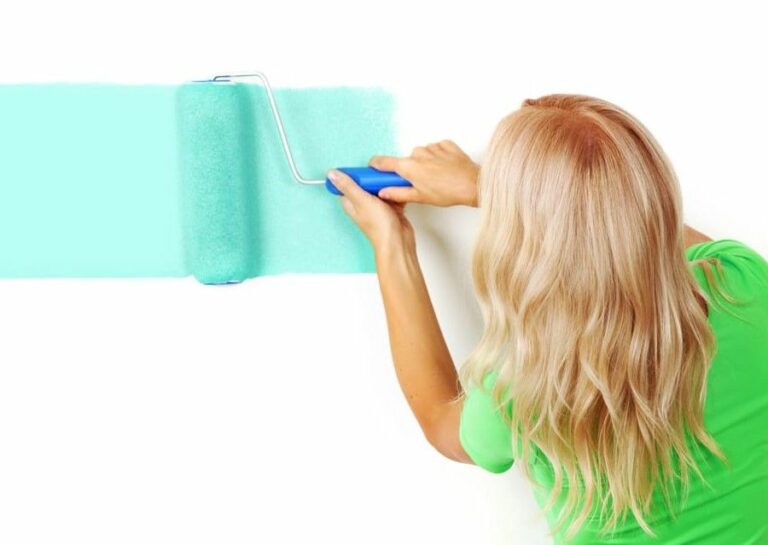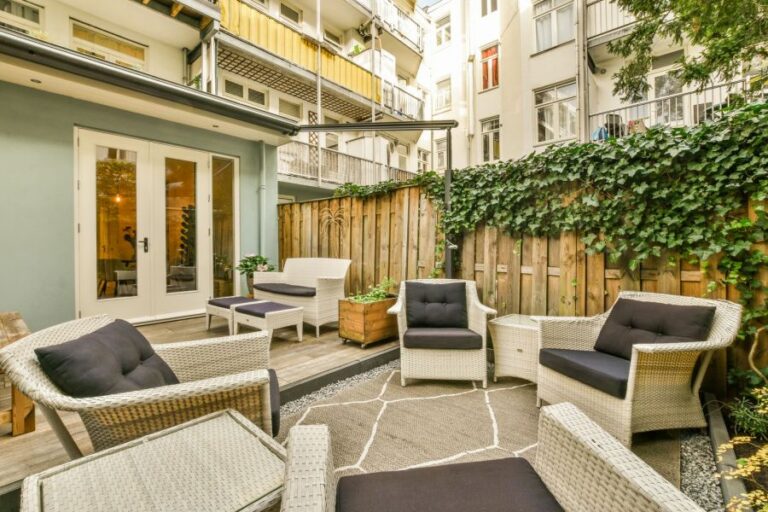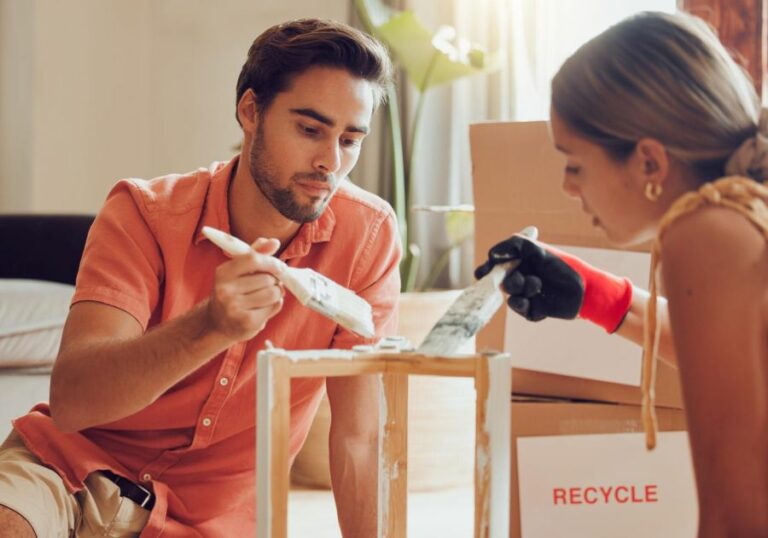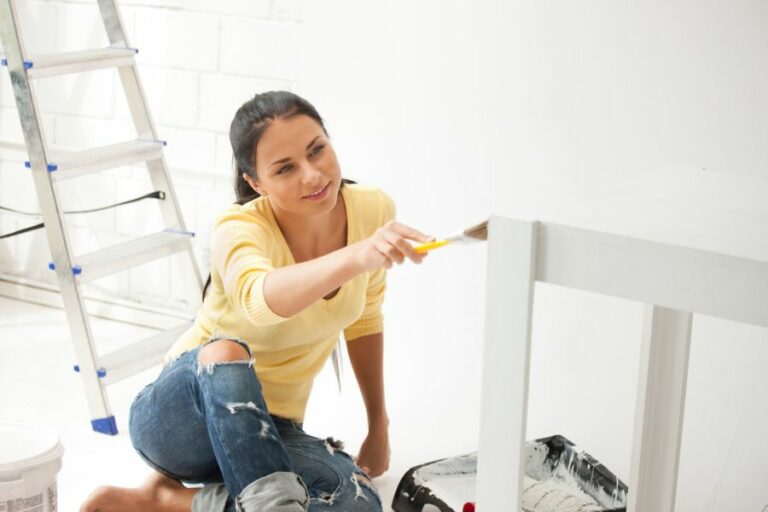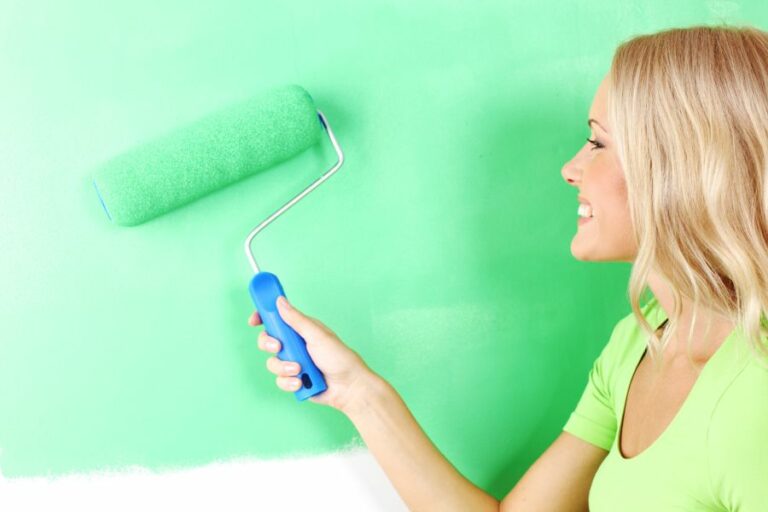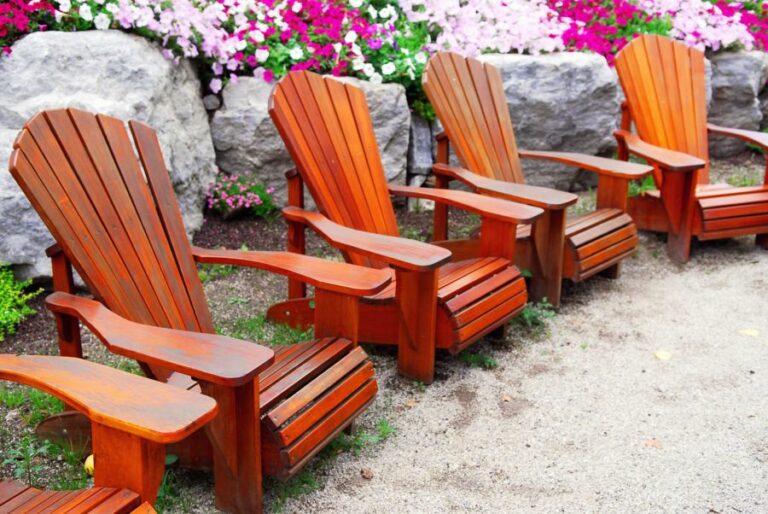Can You Use Chalk Paint On Outdoor Furniture? What Pros Say
Discover the transformative power of chalk paint on your outdoor furniture! Let’s explore whether chalk paint suits exterior use and how to maximize its versatile charm. No longer limited to just indoor furniture makeovers, chalk paint can breathe new life into your worn-out patio set or garden bench. Say goodbye to expensive outdoor furniture updates and embrace the eco-friendly, wallet-saving chalk paint option.
Can you use chalk paint on outdoor furniture:
Chalk paint can be used on outdoor furniture, providing a beautiful, durable, and water-resistant finish. It is easy to apply, versatile, and hard-wearing. However, it requires regular maintenance and may not withstand extreme weather conditions. To achieve the best results, use high-quality outdoor chalk paint, prepare the furniture properly, and apply a protective layer of wax or water-based polyurethane.

Discover the transformative properties of chalk paint on outdoor furniture in this informative article. Learn about the advantages, application techniques, and precautions you should take to revive and protect your furniture effectively for long-lasting results.
Contents
- 1 Is it possible to utilize chalk paint on outdoor furniture?
- 2 What is the Proper Method for Sealing Chalk Paint on Outdoor Furniture?
- 3 Is it Possible to Make Chalk Paint Waterproof?
- 4 The Best Chalk Paint for Outdoor Furniture: A Comprehensive Guide
- 5 How can you effectively protect chalk-painted wood from water damage?
Is it possible to utilize chalk paint on outdoor furniture?
Chalk paint is an incredible option for refreshing old and worn-out furniture. Its versatility and ease of use make it a popular choice for many DIY enthusiasts. However, many people wonder if it is suitable for outdoor furniture too.
Let’s explore the possibility of using chalk paint on outdoor furniture, learn about the steps to paint furniture with chalk paint, and discuss the benefits and potential drawbacks of using chalk paint outside.
• Benefits of Using Chalk Paint on Outdoor Furniture
There are several advantages of using chalk paint on outdoor furniture. Here are some of the benefits that make it an excellent option:
– Easy Application
The primary reason why many people choose chalk paint is that it is effortless to apply. You do not need to prime or sand the furniture beforehand. This convenience saves you time and effort while still achieving a beautiful finish.
– Durability
Chalk paint is hard-wearing and can withstand daily wear and tear both indoors and outdoors. The paint is unique because it seals and protects the furniture through its strong finish.
– Water Resistance
Although not completely waterproof, chalk paint is water-resistant, an essential feature for outdoor furniture exposed to different weather elements.
– Versatility
Chalk paint adheres to various surfaces, making it a suitable choice for painting outdoor furniture, including wood, metal, plastic, and even glass.
• Preparing Your Outdoor Furniture for Chalk Paint
Before you start painting your outdoor furniture with chalk paint, you need to ensure the surface is clean and ready for painting. Follow these simple steps to get your furniture ready:
- Clean the Furniture: It is essential to remove any dirt, dust, or mildew to ensure the paint adheres to the surface. Use a mild soap and water solution to clean the furniture, and then leave it to dry completely.
- Repair Damages: Examine the furniture for any cracks, loose screws, or broken parts. If necessary, repair the damages before you start painting.
- Remove Loose Paint: If there is any flaking or peeling paint on the furniture, you should remove it by scraping it off with a stiff brush or sandpaper.
- Wipe Down the Surface: Once you have cleaned and repaired the furniture, use a lint-free cloth to remove any remaining dust or debris.
• Steps to Chalk Paint Outdoor Furniture
Once your outdoor furniture is prepared, follow these steps to achieve a gorgeous finish with chalk paint:
- Choose Your Chalk Paint: Many brands of chalk paint are available on the market. I recommend using high-quality paint specifically designed for outdoor use to ensure the best results and durability.
- Apply the First Coat: Using a natural bristle brush, apply a thin layer of chalk paint to the furniture. Be sure to cover the entire surface with an even and smooth coat.
- Let the Paint Dry: After applying the first coat, let the paint dry for at least an hour or the recommended drying time stated on the paint can.
- Sanding for Smooth Finish: If you prefer a smooth finish, you can lightly sand the dried paint with fine-grit sandpaper (220 grit). Remember to wipe off any dust before moving on.
- Apply a Second Coat: Once the first coat is dry, apply a second coat of chalk paint. This coat will give the furniture a more durable and even finish.
- Finishing Touch: After the second coat has dried, you can apply a wax or water-based polyurethane to seal and protect the paint. Make sure to choose a product specifically designed for outdoor use to ensure long-lasting protection.
• Potential Drawbacks of Using Chalk Paint on Outdoor Furniture
While there are many benefits to using chalk paint on outdoor furniture, some potential drawbacks should be considered:
- Limited Protection: Chalk paint has limited water resistance and may not withstand harsh outdoor elements, especially in areas with extreme weather conditions.
- Regular Maintenance: Depending on the level of exposure to weather, outdoor chalk-painted furniture may need regular maintenance in the form of reapplication of paint or sealing.
- Slightly More Expensive: High-quality chalk paints specifically designed for outdoor use can be more expensive than standard outdoor paints.
• Final Thoughts
In conclusion, you can definitely use chalk paint on outdoor furniture, and doing so can create a beautiful, durable, and water-resistant finish.
However, selecting high-quality paint specifically designed for outdoor surfaces is essential, preparing the furniture adequately, and following the steps outlined in this article to achieve the best results. Regular maintenance is crucial to ensure long-lasting durability for your chalk-painted outdoor furniture.
What is the Proper Method for Sealing Chalk Paint on Outdoor Furniture?
• Why Sealing Chalk Paint is Important
Chalk paint is an excellent choice for outdoor furniture, as it provides a vintage, matte finish that will age gracefully over time.
However, as outdoor furniture is exposed to weather elements like rain, sunlight, and temperature changes, it’s essential to seal your chalk paint to protect it from damage and prolong its life.
Sealing the chalk paint will also make your outdoor furniture easier to clean, more resistant to scratches and stains, and give it a protective barrier against moisture and mildew.
• Choosing the Right Sealant for Outdoor Furniture
There are several options when it comes to choosing the right sealant for outdoor furniture. Choosing a sealant that will work well with chalk paint and provide the necessary protection and durability for outdoor use is essential. Some popular sealants for outdoor furniture include:
- Wax: A popular choice for sealing indoor chalk-painted furniture, the wax may not be the most suitable option for outdoor furniture, as it can melt in extreme heat and isn’t as durable as other sealants.
- Polyurethane: A heavy-duty sealant that’s perfect for outdoor furniture, polyurethane comes in various finishes, including matte, satin, and glossy options. Choosing a water-based polyurethane for chalk paint is essential, as oil-based versions can cause the paint to turn yellow.
- Polycrylic: This water-based sealant is similar to polyurethane but dries much faster, making it an excellent choice for sealing outdoor chalk-painted furniture. Like polyurethane, polyacrylic is available in a range of finishes.
- Outdoor-specific sealants: Some sealants are specifically designed for outdoor use and are formulated to provide superior protection against UV rays, moisture, and other elements. Examples of these sealants include Rust-Oleum NeverWet and spar urethane.
• Preparing Your Outdoor Furniture for Sealing
Before you can apply a sealant to your chalk-painted outdoor furniture, it’s essential to prepare the surface properly. This ensures the sealant will adhere well and provide the best protection possible.
- Clean your furniture thoroughly. Dirt, dust, and grime can interfere with the sealant’s adhesion, so make sure to clean your outdoor furniture with a soft brush, a mild soap solution, and warm water. Rinse thoroughly and allow it to dry completely before proceeding.
- Sand the chalk-painted surface lightly. Although one of the benefits of chalk paint is that it doesn’t require thorough sanding before applying a topcoat, lightly sanding the surface with fine-grit sandpaper (220-grit or higher) will ensure better adhesion of the sealant. Remember to sand gently to avoid removing too much paint.
- Remove any sanding residue. After sanding, use a tack or slightly damp cloth to remove any sanding dust and residues from the surface.
• Applying the Sealant to Chalk Painted Outdoor Furniture
Once your outdoor furniture is clean and prepared, you can proceed with applying the chosen sealant. Follow these steps for a successful application:
- Choose the appropriate brush: Depending on the sealant you’ve chosen, you may need a particular type of brush for applying it. Synthetic brushes are ideal for water-based sealants like polycrylic, while natural bristle brushes work well for oil-based outdoor sealants.
- Stir the sealant: Before applying the sealant to your furniture, make sure to stir it thoroughly using a stir stick. This will ensure the sealant’s consistency and prevent bubbles from forming when applying it to the surface.
- Apply the sealant: Following the manufacturer’s instructions, use your brush to apply a thin and even layer of the sealant over the chalk paint. Be cautious not to apply too much sealant, as thick layers can result in dripping and pooling, which can affect the finished appearance of your furniture.
- Allow the sealant to dry: The drying time will vary depending on your specific sealant. Ensure you’re following the manufacturer’s recommended drying times between each coat.
- Apply additional coats: For outdoor furniture, multiple coats of sealant are recommended to provide the best possible protection. Usually, two to three coats are sufficient. Remember to allow each coat to dry before applying the next one, and follow the manufacturer’s recommended drying times.
- Lightly sand between coats: When using a sealant that requires sanding between coats, like polyurethane or polycrylic, wait until the previous coat has dried completely, and then gently sand using a fine-grit sandpaper. Make sure to remove any sanding residue before applying the next coat.
- Allow the final coat to cure: After applying the final coat of sealant, allow it to cure for the recommended time before using your outdoor furniture. This will ensure the sealant has bonded correctly to the chalk paint and provide the best possible protection.
• Conclusion
Sealing chalk paint on outdoor furniture is an essential step to protect its finish and ensure its longevity. By choosing the right sealant, properly preparing the furniture, and following the application guidelines, you can enjoy beautiful and durable outdoor furniture for years to come.
Step | Instructions |
|---|---|
1 | Clean the furniture: Ensure the outdoor furniture is clean of dirt, grease, and other substances that may interfere with paint adhesion. |
2 | Apply chalk paint: Stir the chalk paint well and apply it to the furniture using a high-quality brush or roller, following the paint’s instructions for coverage and drying times. |
3 | Let it dry: Allow the chalk paint to dry completely. This may take anywhere from a few hours to overnight, depending on the manufacturer’s recommendations and weather conditions. |
4 | Sand, if desired: If you prefer a more distressed or smooth finish, lightly sand the painted surface using a fine-grit sandpaper, taking care not to remove too much paint. |
5 | Apply sealing product: Choose a sealing product suitable for outdoor use, such as a non-yellowing polyurethane. Follow the manufacturer’s instructions on application and drying times. |
6 | Let it dry and cure: Allow the sealing product to dry completely and cure as recommended by the manufacturer before placing the furniture outdoors or subjecting it to heavy use. |
7 | Maintenance: Inspect and reseal the furniture periodically to maintain its durability and appearance. |
Is it Possible to Make Chalk Paint Waterproof?
Chalk paint is a popular choice for DIY enthusiasts and professionals alike when it comes to revamping furniture and home decor.
Its versatility and ease of use make it a great option for upcycling projects. However, one drawback of using chalk paint is that it tends to be less durable and more prone to damage from moisture.
So, the question is: can you make chalk paint waterproof? The answer is yes; you can make chalk paint waterproof with a few simple steps.
• Choosing the Right Sealant
The key to making chalk paint waterproof is by applying a suitable sealant over the painted surface. Various sealants are available in the market that will help protect your chalk paint project from moisture and wear, making it a long-lasting and durable finish.
Let’s discuss some popular sealant options for your chalk paint projects:
– Water-Based Polyurethane
Water-based polyurethane is an excellent choice for sealing chalk paint and providing a waterproof finish. It is easy to apply, dries quickly, and is available in a variety of sheens, from matte to glossy. This sealant is also known for being eco-friendly and having a low odor, making it ideal for indoor use.
Recommendation: When using water-based polyurethane, it is essential to apply thin, even coats, preferably using a high-quality synthetic brush or foam applicator. Lightly sand between each coat with fine-grit sandpaper to maintain a smooth finish.
– Wax
Wax is a popular sealant for chalk paint, particularly due to its ability to provide an enhanced, aged look to the painted surface. It comes in different formulas, such as soft wax or paste wax, and can be applied with a brush or cloth.
While wax does not provide the same level of waterproof protection as polyurethane, it can still offer a reasonable level of protection from moisture when applied correctly.
Recommendation: Apply thin coats of wax and buff between each application to achieve a polished and smooth finish. It’s crucial to allow enough curing time (about 24 hours) before using or handling the painted item.
– Acrylic Sealants
Acrylic sealants, such as clear, non-yellowing acrylic spray or brush-on sealants, are another excellent option for waterproofing chalk paint. They provide UV protection and come in various sheens, from matte to glossy.
These sealants are easy to apply and fast-drying, making them suitable for both indoor and outdoor projects.
Recommendation: As with other sealants, apply thin coats of the acrylic sealant evenly with a brush or spray can. Be sure to follow the manufacturer’s instructions for drying and curing times to achieve the best results.
• Proper Application Tips for Waterproofing Chalk Paint
To ensure a successful, long-lasting waterproof finish for your chalk paint project, it is critical to prepare and apply the chosen sealant properly. Here are some essential tips to follow:
– Clean and Prepare the Surface
Before applying any sealant, it is crucial to clean your chalk-painted surface thoroughly. Remove any dust, debris, or dirt from the surface, and if using wax, ensure no residual wax is on the surface.
– Application Conditions
Ensure that the environment where the sealant is applied is suitable for the chosen product. In general, it is advisable to avoid working in high humidity or extreme temperatures, as this can affect the drying and curing of the sealant.
– Apply Sealant in Thin, Even Coats
Whether using a brush or spray, applying thin, even coats of the chosen sealant across the entire surface of your chalk paint project is crucial. Doing so reduces the potential for uneven sheen or finish and ensures adequate coverage for waterproofing.
– Allow Adequate Drying and Curing Time
Each sealant product has specific drying and curing times listed on the label, and it is essential to follow these guidelines. Giving your chalk paint project enough time to dry and cure will provide better protection and durability in the long run.
• Final Thoughts
Creating a waterproof finish on your chalk paint project is achievable and essential for maintaining your work’s longevity and durability.
By selecting the right sealant and following proper application techniques, you can achieve a waterproof finish that will protect your chalk paint creations from moisture damage for years to come.
So go ahead and enjoy the creative process of chalk painting with the added confidence that your work will withstand the test of time.
| Can you make chalk paint waterproof? | |
|---|---|
| Chalk paint | Chalk paint is a decorative paint known for its matte, chalky appearance, often used for furniture and home decor projects. |
| Waterproofing | While chalk paint itself is not waterproof, it can be protected and sealed with a topcoat or wax. |
| Topcoat or wax | Applying a clear topcoat (such as polycrylic or polyurethane) or furniture wax to chalk-painted surfaces can help protect them from water and moisture, enhancing durability and longevity. |
| Limited waterproofing | While the application of a topcoat or wax can help protect chalk-painted surfaces from water and moisture, it may not make the surface completely waterproof. It is still essential to avoid submerging the painted item in water or exposing it to excessive moisture for long periods. |
The Best Chalk Paint for Outdoor Furniture: A Comprehensive Guide
Choosing the right paint for outdoor furniture is essential to ensure they look great and last longer. Chalk paint is an increasingly popular choice for outdoor furniture due to its versatility, durability, and ease of use. But what is the best chalk paint for outdoor furniture?
• Why Choose Chalk Paint for Outdoor Furniture?
Chalk paint is known for its ability to adhere well to various surfaces, making it an ideal choice for outdoor furniture. With its quick-drying nature and minimal preparation, chalk paint saves both time and energy.
Additionally, the matte finish it leaves on furniture is both aesthetically pleasing and relatively low maintenance.
• Top Chalk Paints for Outdoor Furniture
1. Annie Sloan Chalk Paint
Annie Sloan is a household name within the chalk paint world, with a reputation for providing high-quality, reliable products. The paints formula is specifically designed for use on furniture and provides excellent coverage with just one or two coats.
It is available in multiple colors and can be easily mixed to create custom shades. Due to its proven performance and results, I highly recommend considering Annie Sloan Chalk Paint for your outdoor furniture projects.
2. Rust-Oleum Chalked Paint
Rust-Oleum offers a durable and protective chalk paint suitable for outdoor furniture. This paint is known for its excellent adhesion and long-lasting finish, making it ideal for increased exposure to the elements.
Rust-Oleum Chalked Paint also dries quickly and is available in various colors, allowing for customization of your furniture pieces.
3. DecoArt Americana Decor Chalky Finish Paint
DecoArt offers a wide range of chalky finish paints that work well on outdoor furniture. These paints are water-based and known for their excellent coverage, requiring fewer coats than other paints.
Moreover, DecoArt Americana Decor Chalky Finish Paint is available in a vast array of colors, making it easy to mix and match or create unique finishes.
• Factors to Consider When Choosing the Best Chalk Paint
1. Surface Type and Condition
The type and condition of the surface you will be painting play a crucial role in determining the best chalk paint for your needs. Different brands have varying levels of adhesion, and some may perform better on specific materials like wood, metal, or plastic.
Additionally, surfaces in poor condition may require extra preparation or the use of a primer to achieve the desired finish.
2. Exposure to the Elements
Outdoor furniture is exposed to a variety of environmental factors, including sunlight, rain, and temperature fluctuations. When selecting the best chalk paint, consider its durability against these factors.
Some paints include UV protection and waterproof finishes designed for outdoor furniture use.
3. Color Selection
Choose a chalk paint that offers a wide range of color options to match your outdoor space design. Some brands also allow you to mix their paints to create custom shades, providing you with numerous possibilities for personalizing your furniture pieces.
4. Maintenance and End Finish
The end finish of chalk paint can vary from matte to satin, depending on the paint type and brand chosen. Select a paint with your desired finish and take into consideration the required maintenance for that specific finish.
Some finishes may require more frequent touch-ups or additional protective topcoats to maintain their appearance.
• Tips for Applying Chalk Paint to Outdoor Furniture
- Clean your furniture before painting: Remove any dirt, dust, or debris from the surface of your furniture, and allow it to dry fully before applying chalk paint.
- Lightly sand the surface (if necessary): Depending on the surface type and condition, it may be necessary to lightly sand the surface before painting to help the paint adhere better.
- Apply an appropriate primer (if necessary): Some surfaces may require the use of a primer before you apply your chalk paint to ensure better adhesion and coverage.
- Use a high-quality brush or roller: Investing in a high-quality brush or roller will help you achieve better coverage and a smoother finish when painting your outdoor furniture.
- Apply thin, even coats: Thin coats of chalk paint dry more quickly and evenly, preventing drips and streaks. Allow each coat to dry fully before applying the next.
- Protect your painted furniture: Apply a suitable clear topcoat or wax to your painted outdoor furniture to protect it from the elements and prolong its life.
To sum up, finding the best chalk paint for outdoor furniture will depend primarily on the specific factors related to your project: surface type, exposure to the elements, color preferences, and desired finish.
By considering the top-rated chalk paint options and following our suggestions, you can confidently transform your outdoor furniture, creating a beautiful and functional space to enjoy year-round.
Rank | Brand | Product Name | Features |
|---|---|---|---|
1 | Annie Sloan | Chalk Paint | Highly pigmented, easy to apply, quick-drying, and UV-resistant. |
2 | Rust-Oleum | Chalked Ultra Matte Paint | Durable, one-coat coverage, easy to distress, awarded for excellence in innovative product design. |
3 | FolkArt Home Dcor | Chalk Outdoor Acrylic Paint | Water-based, non-toxic, UV-resistant, weather-resistant, and self-sealing. |
4 | Amy Howard at Home | One Step Paint | Water-based, no priming or sanding required, suitable for various surfaces, and great coverage. |
5 | DecoArt Americana Decor | Chalky Finish Paint | Water-based, non-toxic, low VOC, durable, and easy to distress with a durable finish. |
How can you effectively protect chalk-painted wood from water damage?
Chalk paint is a popular choice for many DIY enthusiasts, as it provides an easy-to-apply, distressed finish to furniture and other wooden surfaces.
However, its porous nature means that it is not naturally waterproof, leaving your chalk-painted wood vulnerable to water damage, stains, and general wear and tear.
• The Importance of Waterproofing Chalk Painted Wood
Waterproofing your chalk-painted wood is essential for several reasons. Firstly, it offers protection from moisture, preventing the wood from warping, swelling, or rotting. Secondly, a waterproof layer can shield the paint from stains, improving its durability and appearance.
Finally, sealing the paint can make it easier to clean and maintain, keeping your wooden items fresh and vibrant for many years.
• Choosing the Right Sealer
Choosing the correct sealer is the key to successfully waterproofing your chalk-painted wood. There are several options available, each with its benefits and drawbacks. In general, there are three types of sealers to consider:
1. Wax
Wax is an excellent choice for those seeking a natural and eco-friendly option. It provides a subtle sheen and is available in various finishes, such as clear, dark, and tinted. Wax is easily applied with a brush or cloth and can be buffed to your desired level of shine.
Pros:
- Natural and eco-friendly
- Easy to apply and buff
- Offers a range of finishes
Cons:
- May require reapplication every few years
- Not as durable as other options
- Can become streaky if not applied correctly
2. Polyurethane
Polyurethane is a popular choice for waterproofing chalk-painted wood, thanks to its durability and strong water resistance. It is available in water- and oil-based formulations, the latter being more robust but having a higher VOC content.
Polyurethane comes in various sheens, from matte to high gloss, allowing you to tailor the finish to your project.
Pros:
- Highly durable and water-resistant
- Wide range of sheens available
- Protects against wear and tear
Cons:
- Can be harder to apply evenly
- Some formulations contain high levels of VOCs
- May yellow over time, particularly on light-colored surfaces
3. Polycrylic
Polycrylic is a water-based alternative to polyurethane, offering similar benefits but with fewer drawbacks. It is non-toxic, low in VOCs, and less prone to yellowing over time, making it an excellent option for those looking for a more eco-friendly and health-conscious sealer.
Pros:
- Eco-friendly, low VOC content
- Non-toxic and less prone to yellowing
- Retains the chalky finish of the paint
Cons:
- Less durable than polyurethane
- May struggle to adhere to very smooth surfaces
- Can be prone to streaking if not applied carefully
• Preparing the Surface
Before applying your chosen sealer, preparing your chalk-painted wood surface is crucial. This involves cleaning the surface to remove any dust, dirt, or debris and ensuring it is completely dry. Damp or dirty surfaces can cause the sealer to bond poorly, resulting in a subpar finish.
• Application Techniques
Once your surface is prepared, it is time to apply your chosen sealer. The process will vary slightly depending on the type of sealer used, but there are some general tips to follow:
- Use a high-quality brush or foam applicator for an even finish
- Apply thin, even coats, being careful not to overwork the sealer
- Allow adequate drying time between coats, as specified by the manufacturer
- Lightly sand the surface between coats, if required, using a fine-grit sandpaper
- Apply at least two to three coats for optimal protection and durability
• Caring for Your Waterproofed Chalk Painted Wood
Once your sealer is fully cured, it is essential to maintain your waterproofed surface to ensure its longevity. Regular cleaning with a soft, damp cloth is recommended to remove dirt and dust without causing damage to the sealer.
If heavy soiling occurs, use a mild detergent diluted in water and gently scrub the surface, taking care not to abrade the finish.
In conclusion, waterproofing chalk-painted wood is a simple yet vital process to protect and preserve your projects. By selecting the right sealer, preparing your surface carefully, and employing proper application techniques, you can ensure a beautiful and durable finish that will stand the test of time.
Step | Action |
|---|---|
1 | Clean the surface of the chalk-painted wood by wiping it with a damp cloth. |
2 | Allow the wood to dry completely before proceeding to the next step. |
3 | Choose a clear and water-resistant sealant (e.g., wax, polyurethane, or polycrylic) that is compatible with your chalk paint. |
4 | Apply the sealant according to the manufacturer’s instructions. This may involve using a brush, cloth, or roller to apply an even layer of the sealant onto the surface of the wood. |
5 | Allow the sealant to dry for the recommended duration, as specified by the manufacturer. |
6 | If desired, apply additional coats of sealant for extra protection, allowing each coat to dry before applying the next one. |

